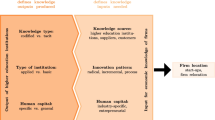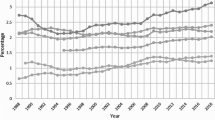Abstract
This paper examines the relationship between knowledge spillovers from universities and new business location in high-technology sectors. We focus on the contribution to new business formation through spillovers stemming from three main university outputs: knowledge-based graduates, research activities, and technological knowledge. We construct a new dataset with information on 604 companies and 63 universities in Spain and group the data across 36 geographical areas from 2001 to 2004 (144 observations). After controlling for several traditional cost factors and agglomeration characteristics, we find that university spillovers are relevant in explaining the location of new businesses in high-technology sectors in Spain. Further, our analysis draws attention to the relevance of graduates as the main source of spillovers, while research activities and university technology do not have significant effects.
Similar content being viewed by others
Notes
Understanding those firm characteristics that benefit from university spillovers is also an important issue. However, we do not review this strand of the literature because we focus on new entrants (new business) in particular. Nevertheless, this particular topic may be relevant in explaining how established firms take advantage of spillovers.
Aerospace (Nace 35.3); pharmaceutical products (24.4); computers and office machinery (30); electronic and telecommunications products (32); scientific instruments (33).
References
Abramovsky, L., Harrison, R., & Simpson, H. (2007). University research and the location of business R&D. The Economic Journal, 117(519), C114–C141.
Acs, Z. J., Fitzroy, F. R., & Smith, I. (1999). High technology employment, wages and university R&D spillovers: Evidence from US cities. Economics of Innovation and New Technology, 8, 57–78.
Anselin, L., Varga, A., & Acs, Z. (1997). Local geographic spillovers between university research and high technology innovations. Journal of Urban Economics, 42, 422–448.
Anselin, L., Varga, A., & Acs, Z. (2000). Geographic and sectoral characteristics of academic knowledge externalities. Papers in Regional Science, 79, 435–443.
Arauzo, J. M., Liviano, D., & Martín, M. (2008). New business formation and employment growth: Some evidence for the Spanish manufacturing industry. Small Business Economics, 30, 73–84.
Armington, C., & Acs, Z. J. (2002). The determinants of regional variation in new firm formation. Regional Studies, 36, 33–45.
Audretsch, D., & Fritsch, M. (1999). The industry component of regional new firm formation processes. Review of Industrial Organization, 15, 239–252.
Audretsch, D., & Keilbach, M. (2004). Entrepreneurship capital and economic performance. Regional Studies, 38, 949–959.
Audretsch, D. B., & Lehmann, E. E. (2005). Does the knowledge spillover theory of entrepreneurship hold for regions? Research Policy, 34, 1191–1202.
Audretsch, D., Lehmann, E., & Warning, S. (2004). University spillovers: Does the kind of science matter? Industry and Innovation, 11, 193–206.
Audretsch, D. B., Lehmann, E. E., & Warning, S. (2005). University spillovers and new firm location. Research Policy, 34, 1113–1122.
Bania, N., Eberts, R., & Fogarty, M. (1993). Universities and the start-up of new companies: Can we generalize from route 128 and silicon valley? The Review of Economics and Statistics, 75, 761–766.
Brenner, T. (2007). Local knowledge resources and knowledge flows. Industry and Innovation, 14, 121–128.
Cameron, A., & Trivedi, P. (1986). Econometrics models based on count data: Comparisons and applications of some estimators and tests. Journal of Applied Econometrics, 1, 29–53.
Cameron, A., & Trivedi, P. (1998). Regression analysis of count data. Cambridge: Cambridge University Press.
Cohen, W., & Levinthal, D. (1990). Absorptive capacity: A new perspective on learning and innovation. Administrative Science Quarterly, 35, 128–152.
Cohen, J. P., & Paul, C. J. M. (2005). Agglomeration economies and industry location decisions: The impacts of spatial and industrial spillovers. Regional Science and Urban Economics, 35, 215–237.
Cohen, W., Nelson, R., & Walsh, J. (2002). Links and impacts: The influence of public research on industrial R&D. Management Science, 48, 1–23.
Crozet, M., Mayer, T., & Mucchielli, J.-L. (2004). How do firms agglomerate? A study of FDI in France. Regional Science and Urban Economics, 34, 27–54.
Di Gregorio, D., & Shane, S. (2003). Why do some universities generate more start-ups than others? Research Policy, 32, 209–227.
Egeln, J. R., Gottschalk, S., & Rammer, C. (2004). Location decisions of spin-offs from public research institutions. Industry and Innovation, 11, 207–223.
Feldman, M., & Florida, R. (1994). The geographic sources of innovation: Technological infrastructure and product innovation in the United States. Annals of the Association of American Geographers, 84, 210–229.
Fischer, M., & Varga, A. (2003). Spatial knowledge spillovers and university research: Evidence from Austria. Annals of Regional Science, 37, 303–322.
Fritsch, M. (2008). How does new business formation affect regional development? Introduction to the special issue. Small Business Economics, 30, 1–14.
Fritsch, M., & Falck, O. (2007). New business formation by industry over space and time: A multidimensional analysis. Regional Studies, 41, 157–172.
Guimaraes, P., Figueiredo, O., & Woodward, D. (2003). A tractable approach to the firm location decision problem. Review of Economics and Statistics, 85, 201–234.
Harhoff, D. (1999). Firm formation and regional spillovers—evidence from Germany. Economics of Innovation and New Technology, 8, 27–55.
Jaffe, A. (1989). Real effects of academic research. American Economic Review, 79, 957–970.
Jaffe, A., Fogarty, M., & Banks, B. (1998). Evidence from patents and patent citations on the impact of NASA and other labs on commercial innovations. Journal of Industrial Economics, 46, 183–205.
Kirchhoff, B. A., Newbert, S. L., Hasan, I., & Armington, C. (2007). The influence of university R&D expenditures on new business formations and employment growth. Entrepreneurship: Theory and Practice, 31, 543–559.
Koo, J. (2007). Determinants of localized technology spillovers: Role of regional and industrial attributes. Regional Studies, 41, 995–1011.
Martinelli, A., Meyer, M., & Tunzelmann, N. (2008). Becoming an entrepreneurial university? A case study of knowledge exchange relationships and faculty attitudes in a medium-sized, research-oriented university. Journal of Technology Transfer, 33, 259–283.
Perkmann, M., & Walsh, K. (2007). University–industry relationships and open innovation: Towards a research agenda. International Journal of Management Reviews, 9, 259–280.
Rathelot, R., & Sillard, P. (2008). The importance of local corporate taxes in business location decisions: Evidence from French micro data. Economic Journal, 118, 499–514.
Reynolds, P. (1994). Autonomous firm dynamics and economic growth in the United States, 1986–1990. Regional Studies, 28, 429–442.
Reynolds, P. D., Miller, B., & Maki, W. R. (1995). Explaining regional variation in business births and deaths: U.S. 1976–88. Small Business Economics, 7, 389–407.
Schartinger, D., Rammer, C., Fischer, M., & Fröhlich, J. (2002). Knowledge interactions between universities and industry in Austria: Sectoral patterns and determinants. Research Policy, 31, 303–328.
Shane, S. (2001a). Technology regimes and new firm formation. Management Science, 47, 1173–1190.
Shane, S. (2001b). Technological opportunities and new firm creation. Management Science, 47, 205–220.
Tamasy, C., & Heron, R. L. (2008). The geography of firm formation in New Zealand. Tijdschrift voor Economische en Sociale Geografie, 99, 37–52.
Thursby, J., & Thursby, M. (2003). Industry/university licensing: Characteristics, concerns and issues from the perspective of the buyer. Journal of Technological Transfer, 28, 207–213.
Van Stel, A. J., & Storey, D. J. (2004). The link between firm births and job creation: Is there a Upas tree effect? Regional Studies, 38, 893–909.
Varga, A. (1998). University research and regional innovation: A spatial econometric analysis of academic technology transfers. Dordrecht: Kluwer Academic Publishers.
Woodward, D., Figueiredo, O., & Guimaraes, P. (2006). Beyond the Silicon Valley: University R&D and high-technology location. Journal of Urban Economics, 60, 15–32.
Wooldridge, J. M. (2002). Econometric analysis of cross section and panel data (1st ed.). Cambridge: MIT Press.
Zucker, L. G., Darby, M. R., & Brewer, M. B. (1998). Intellectual human capital and the birth of U.S. biotechnology enterprises. American Economic Review, 88, 290–306.
Acknowledgements
This research is supported by a grant from the Ministerio de Educación y Ciencia (SEJ2005-08972/ECON) and the Junta de Andalucía (P06-SEJ-02087 and P08-SEJ-03981). Earlier drafts were presented at the 11th European Network on Industrial Policy (EUNIP), San Sebastian (Spain), 10–12 September 2008, and EuroMOT 2008 (International Association for Management of Technology), Nice (France), September 17–19, 2008. The authors express their thanks to colleagues at these conferences for their helpful suggestions. The authors are also very grateful to an anonymous reviewer for constructive and insightful comments on earlier versions of this paper.
Author information
Authors and Affiliations
Corresponding author
Rights and permissions
About this article
Cite this article
Acosta, M., Coronado, D. & Flores, E. University spillovers and new business location in high-technology sectors: Spanish evidence. Small Bus Econ 36, 365–376 (2011). https://doi.org/10.1007/s11187-009-9224-4
Received:
Accepted:
Published:
Issue Date:
DOI: https://doi.org/10.1007/s11187-009-9224-4




